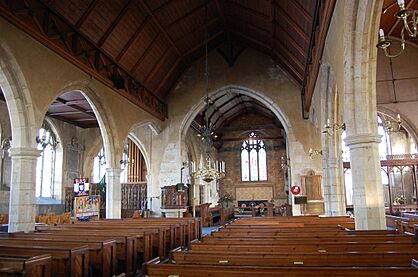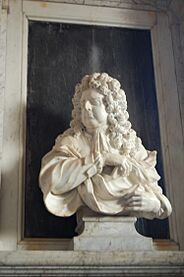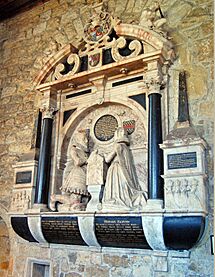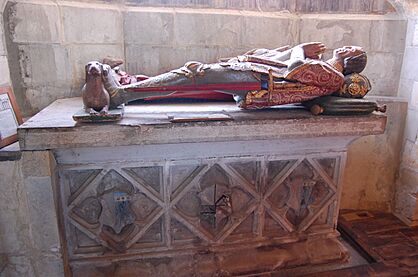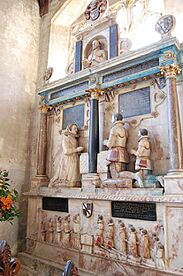St Mary's Church, Goudhurst facts for kids
Quick facts for kids St Mary's Church, Goudhurst |
|
|---|---|
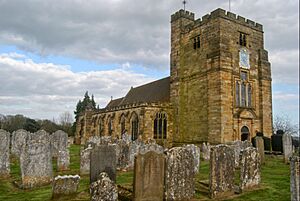 |
|
| Lua error in Module:Location_map at line 420: attempt to index field 'wikibase' (a nil value). | |
| Location | Goudhurst, Kent |
| Country | England |
| Denomination | Anglican |
| History | |
| Status | Parish church |
| Architecture | |
| Functional status | Active |
| Heritage designation | Grade I |
| Designated | 20 June 1967 |
| Completed | Pre-1119 |
| Administration | |
| Parish | Goudhurst |
| Deanery | Weald |
| Archdeaconry | Maidstone |
| Diocese | Canterbury |
| Province | Canterbury |
St Mary's Church is a historic parish church in the village of Goudhurst, in Kent, England. Because of its great age and importance, it is a Grade I listed building, meaning it is protected as a special historic site.
Contents
A Church on a Hill
St Mary's Church sits on top of a hill, and its tower offers amazing views of the countryside. Because of its high location, the tower was used for an important project between 1784 and 1790. Scientists used it as a survey point to accurately measure the distance between the observatories in Paris and Greenwich, London.
The church is a large building made of sandstone, first built in the 13th century. It has been changed and repaired many times over hundreds of years. In 1637, a lightning strike destroyed the tower and its 115-foot-tall spire. A year later, three masons from London rebuilt the tower in a mix of old and new styles.
Inside the Church
The inside of the church has many interesting features.
- The main hall, or nave, has five large arches on each side.
- The pulpit, where the vicar gives sermons, is decorated with carved figures of the apostles.
- The font, used for baptisms, has a bowl from the 19th century that sits on a much older base from the 15th century.
- There are beautiful wooden screens that separate the side chapels. Part of one screen was carved to remember soldiers who fought in the First World War.
Between 1865 and 1870, the church was carefully restored by architects to bring it back to its former glory.
The Story of St Mary's
The first record of a church in Goudhurst was in the year 1119. The first church was probably a small building on the same spot where the south chapel is today. Over the centuries, the church grew and became the large building we see now.
The Battle of Goudhurst
In 1747, a real battle was fought in the church and its churchyard. A local group called the Goudhurst Militia, led by a former army corporal named William Sturt, stood up to a notorious group of smugglers known as the Hawkhurst Gang.
The gang's leader, Thomas Kingsmill, was angry that the villagers had formed a militia. He threatened to attack the village unless the militia was broken up. When his demands were ignored, the gang attacked on April 21, 1747.
However, the Goudhurst Militia was well-prepared. They fought bravely around the church and defeated the smugglers. Kingsmill's brother was killed in the fighting, and two other smugglers also died. The leader, Thomas Kingsmill, was later captured and faced justice for his crimes.
Famous Tombs and Memorials
Inside the church, there are many monuments and tombs for important people from the area's history.
- The Culpeper Tombs: The church is famous for its monuments to the Culpeper family. One amazing monument is for Sir Alexander Culpeper, who died in 1537. It features a life-sized wooden figure of him lying on a chest. This type of wooden tomb is very rare, with only about 80 like it in the whole country. Another monument shows a later Sir Alexander Culpeper (who died in 1599) with carvings of his 16 grandchildren.
- The Campion Memorials: A large monument is dedicated to William Campion and his wife Rachel, who died in the early 1600s. It shows them kneeling at a prayer desk, with figures of their nine children carved on the sides.
- The 'Bread Tomb': A simple tomb for John Bathurst (who died in 1697) is known as the 'Bread Tomb'. This is because loaves of bread were once laid out on it each week to be given to the poor people of the village.
Gallery
-
The bust on the monument of politician William Campion.
See also
- Website of St Mary's Church, Goudhurst
- Goudhurst


